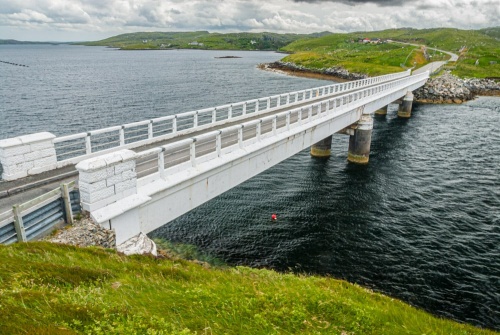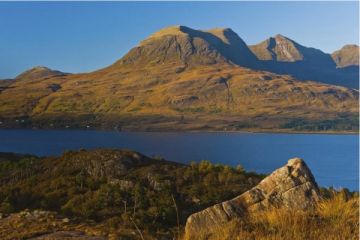
Great Bernera Bridge links Great Bernera to the Isle of Lewis at Earshader. The bridge was built in 1953 and is one of the very first bridges in the world to use pre-stressed concrete.
The bridge spans a narrow channel in Loch Roag, a sea loch that flows directly into the Atlantic Ocean. For this reason, Great Bernera Bridge is also known as The Bridge Over the Atlantic, a name that also applies to a similar bridge at Clachan Seil in Argyll.

History
Great Bernera is separated from Lewis by a narrow strait of water known as Struth Iarsiadair in Gaelic. The strait connects Loch Barraglom to the east with the western arm of Loch Roag. Until the bridge was erected, the only way to reach Great Bernera was by boat. An on-demand ferry crossed from Earshader on Lewis to Barraglom on the northern side of the strait, carrying everything from lorries to livestock. When cattle had to be moved from one bank to the other, they had to make the crossing by swimming behind the ferry.
The ferry was frequently unable to run due to the strong currents that ran through the strait, or in times of high winds, which are frequent in the region.
After much lobbying by the residents of Great Bernera the decision to build a bridge across the strait was made in 1951.

Construction
The construction method chosen was to use pre-stressed concrete. This method of construction required only 25% of the steel used in ordinary reinforced concrete. In the aftermath of World War Two there was a severe shortage of steel, so using pre-stressed concrete made perfect sense.
The design called for three separate spans supported on two pairs of pillars and concrete abutments on both ends. With a total length of 108 feet, Great Bernera Bridge was the second-longest bridge of its type in the world. So innovative was the concept considered at the time that a scale model of the bridge was exhibited at the Festival of Britain in 1951.
The piers were concrete tubes filled with more concrete. In order to sink the pillars into the sea floor, divers had to excavate holes. The strong currents running through the strait made this work very dangerous, and the divers had to be tied to scaffolding while they worked.

During the process of excavating holes for the piers, divers discovered the remains of a causeway on the sea floor. This causeway was recorded in a 17th-century book but may be much older.
The piers were put in place first, then beams were lowered into place on the pier caps. The first beam slipped as it was being put in place and fell, breaking into two pieces. One of these pieces was found during repair work in 1998 and now lies on the shore.
While the construction technique may have been innovative, building the bridge relied on manual labour. Twenty-five local men were hired as labourers, and they carried away tonnes of rock and earth in wheelbarrows and with the aid of a temporary tramway.
The bridge cost an estimated £70,000 and was officially opened on 22 July 1953. A crowd of between 2,000 and 4,000 people watched the opening ceremony. If those estimates of the crowd size are accurate, this was one of the largest public gatherings in the history of the Western Isles.
Eighty-five per cent of the cost was borne by the government (sixty per cent by the transport ministry and twenty-five per cent by the ministry of agriculture) and the remaining fifteen per cent by the Ross and Cromarty County Council (the Western Isles then being considered part of Ross and Cromarty).
Old photographs showing the bridge construction and the opening ceremony can be seen at the island museum at Breaclete.
On a rocky cliff above the northern end of the bridge stands the Bernera Bridge Stone Circle (Callanish VIII), an unusual arrangement of standing stones that may have performed as a kind of astronomical observatory, perhaps linked to the famous stone circle complex at Callanish, three miles to the east across Loch Roag.
Getting There
Great Bernera Bridge carries the B8059 to Great Bernera island. From Stornoway, take the A858 west and turn off onto the B8011 at Garynahine. After about 4 miles turn right onto the B8059, signposted the Great Bernera. The road passes through Crulabhig and Earshader before you reach the bridge.
There is a picnic area and viewpoint on the Great Bernera end of the bridge, where you will find an information panel explaining the history of the bridge and its role in connecting the island of Great Bernera to the rest of the Western Isles.
About Great Bernera Bridge
Address: B8059,
Earshader,
Isle of Lewis,
Western Isles,
Scotland
Attraction Type: Historic Building
Location: On the B8059 between Earshader on Lewis and Barraglom on Great Bernera. There is a car park and picnic area on the Great Bernera end of the bridge.
Location map
OS: NB164341
Photo Credit: David Ross and Britain Express
NEARBY HISTORIC ATTRACTIONS
Heritage Rated from 1- 5 (low to exceptional) on historic interest
Bernera Bridge Stone Circle - 0.1 miles (Prehistoric Site) ![]()
Callanish Standing Stones - 3.1 miles (Prehistoric Site) ![]()
Bostadh Iron Age House - 4 miles (Prehistoric Site) ![]()
Dun Carloway Broch - 4.6 miles (Prehistoric Site) ![]()
Gearrannan Blackhouse Village - 6.5 miles (Museum) ![]()
Shawbost Norse Mill and Kiln - 9 miles (Museum) ![]()
Achmore Stone Circle - 9.8 miles (Prehistoric Site) ![]()
Pairc Deer Raiders Memorial - 10.8 miles (Historic Building) ![]()
Nearest Holiday Cottages to Great Bernera Bridge:
Nearby accommodation is calculated 'as the crow flies' from Great Bernera Bridge. 'Nearest' may involve a long drive up and down glens or, if you are near the coast, may include a ferry ride! Please check the property map to make sure the location is right for you.
Cromore, Highlands and Islands
Sleeps: 4
Stay from: £477.00 - 1641.00
Duntulm, Highlands and Islands
Sleeps: 6
Stay from: £417.00 - 2071.00
Staffin, Highlands and Islands
Sleeps: 5
Stay from: £461.00 - 2647.00
More self catering near Great Bernera Bridge



